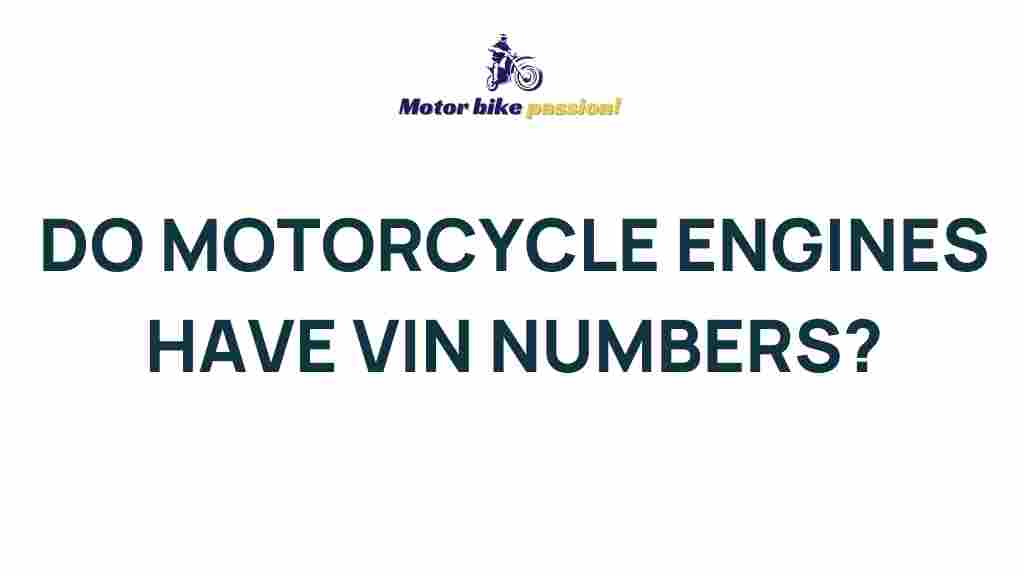Uncovering the Mystery: Do Motorcycle Engines Have VIN Numbers?
When it comes to motorcycle ownership and registration, understanding motorcycle engines and their identification methods is crucial. One common question that arises is whether motorcycle engines have VIN numbers. This article delves into the details of VIN numbers, their significance, and how they relate to motorcycle engines, vehicle history, and registration.
What is a VIN Number?
A Vehicle Identification Number (VIN) is a unique alphanumeric code assigned to every motor vehicle when it’s manufactured. This 17-character string serves as a fingerprint for the vehicle, providing essential information about its make, model, year, and place of manufacture. VINs are vital for various reasons, including:
- Registration: VINs are used by authorities to register vehicles.
- Vehicle history: VINs help track the history of a vehicle, including accidents, ownership changes, and recalls.
- Insurance: Insurance companies use VINs to assess risk and determine premiums.
- Theft recovery: VINs play a crucial role in recovering stolen vehicles.
Do Motorcycle Engines Have VIN Numbers?
The answer is both yes and no. While motorcycle engines themselves do not have dedicated VIN numbers, they are closely tied to the motorcycle’s overall VIN. Here’s how it works:
- The VIN is typically located on the frame of the motorcycle instead of the engine.
- However, some motorcycle manufacturers will stamp the VIN or a portion of it on the engine itself.
- This stamping helps in verifying the authenticity of the motorcycle’s identity.
Understanding the Connection Between VIN Numbers and Motorcycle Engines
To further understand the relationship between motorcycle engines and VIN numbers, let’s break it down:
The Role of VIN in Motorcycle Manufacturing
During the manufacturing process, each motorcycle is assigned a VIN that contains important information about the vehicle. This information includes:
- World Manufacturer Identifier (WMI): The first three characters of the VIN indicate the manufacturer.
- Vehicle Descriptor Section (VDS): Characters four to nine describe the motorcycle model, type, and other specifications.
- Vehicle Identifier Section (VIS): The last eight characters provide specific information about the production year, place, and serial number.
Where to Find the VIN on a Motorcycle
Locating the VIN on a motorcycle is essential for registration and identification purposes. Here are common locations where you can find the VIN:
- Frame: The most common location is on the right side of the motorcycle frame, often near the steering head.
- Engine: Some manufacturers stamp the VIN on the engine as well, though it is less common.
- Under the seat: In some cases, the VIN can be found under the seat or on the body panels.
Why VIN Numbers Matter for Motorcycle Engines
The significance of VIN numbers extends beyond mere identification. Here are key reasons why they matter:
Vehicle History
A VIN allows potential buyers or owners to check the motorcycle’s history. This can include:
- Previous ownership.
- Accident history.
- Service records.
- Recalls or safety issues.
By understanding a motorcycle’s history, owners can make informed decisions regarding purchase and maintenance.
Registration
When registering a motorcycle with local authorities, the VIN is a critical component. It ensures that the motorcycle is legally recognized and can be tracked in case of theft or other legal issues.
Insurance
Insurance companies utilize VINs to assess risk. By evaluating the history associated with a VIN, insurers can determine appropriate coverage and premiums for the motorcycle.
Step-by-Step Process for Checking Your Motorcycle’s VIN
To ensure you have the correct VIN and understand your motorcycle’s identity, follow these steps:
Step 1: Locate the VIN
Refer to the locations mentioned above to find your motorcycle’s VIN. Make sure to check multiple areas if necessary.
Step 2: Verify the VIN
Once you locate the VIN, verify it by cross-checking it with the title and registration documents of the motorcycle.
Step 3: Conduct a Vehicle History Check
Use the VIN to perform a vehicle history check through services like Carfax or AutoCheck. This will provide you with detailed information about the motorcycle’s past.
Step 4: Document the VIN
Keep a record of the VIN for your personal documentation and future reference. This can help in any future transactions or legal matters regarding the motorcycle.
Troubleshooting Common VIN-Related Issues
While VINs are generally straightforward, issues can arise. Here are some common problems and how to troubleshoot them:
Problem: Unable to Find the VIN
If you can’t find the VIN, try the following:
- Check under the seat or body panels.
- Consult the owner’s manual for your specific motorcycle model.
- Contact the manufacturer or a dealership for assistance.
Problem: VIN Doesn’t Match Registration
If the VIN on your motorcycle does not match the registration documents, consider these steps:
- Double-check the VIN for errors in transcription.
- Contact your local Department of Motor Vehicles (DMV) for guidance.
- Consult a legal expert if there are discrepancies involving ownership.
Problem: Stolen Motorcycle with VIN Issues
If you suspect your motorcycle is stolen or has a fraudulent VIN, take immediate action:
- Report your findings to the police.
- Provide them with all documentation you have regarding the motorcycle.
- Follow up with your local DMV to ensure proper procedures are followed.
Conclusion
In conclusion, while motorcycle engines do not have their own dedicated VIN numbers, they are closely associated with the motorcycle’s overall VIN. Understanding VIN numbers is crucial for identification, vehicle history, registration, and ensuring that you are aware of any potential issues related to your motorcycle. By knowing how to locate and verify the VIN, you can protect yourself as an owner and make informed decisions regarding your motorcycle.
For more information on motorcycle ownership and maintenance, check out our comprehensive guides on motorcycle care.
This article is in the category Basic Guides and created by MotorBikePassion Team
